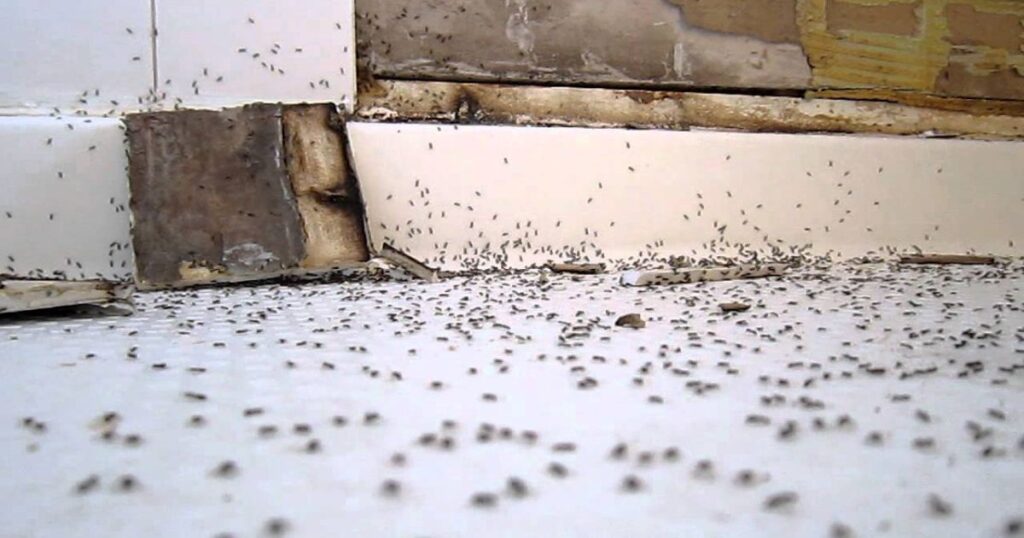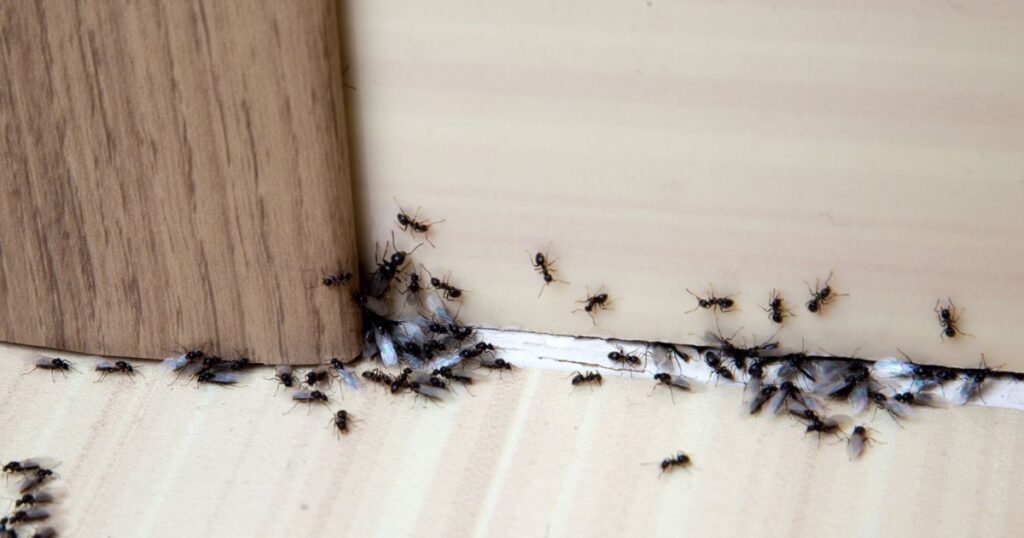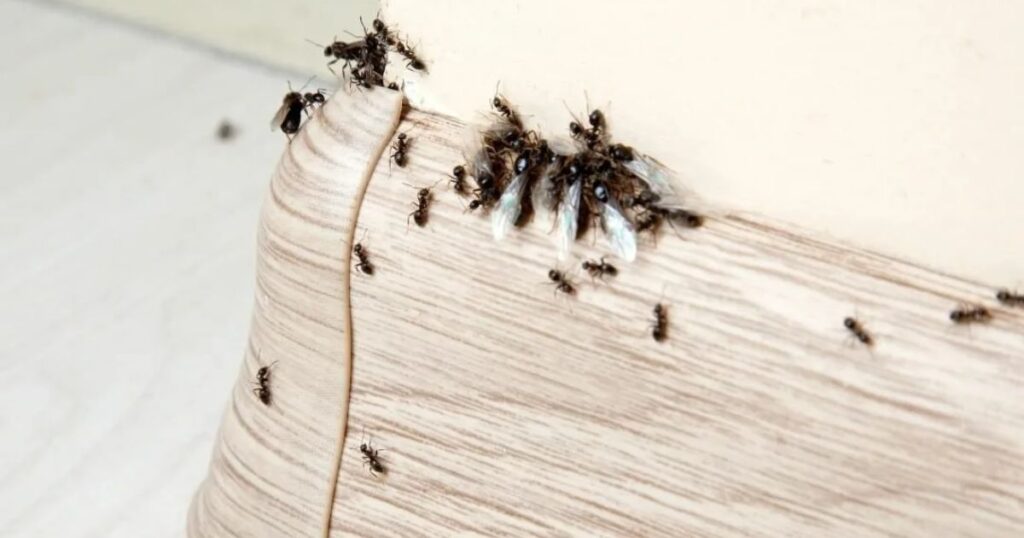Ants in your bathroom? It’s a common household issue that can be frustrating and unsanitary. These persistent pests can find their way into even the most private spaces, turning your bathroom into their ant colony. If you’re dealing with tiny ants in your bathroom or an ant infestation in your shower, don’t worry – this guide will equip you with the knowledge and strategies to get rid of them for good.
Key Takeaways
- Ants in bathrooms are often attracted by moisture, food crumbs or residue, hair/dead skin, and fragrant products like soap or shampoo.
- Identifying the types of ants you’re dealing with is crucial for effective treatment.
- Eliminating food and water sources, sealing entry points, and combining natural and chemical treatments can help eliminate bathroom ants.
- Regular cleaning routines and maintenance are critical for long-term prevention.
- Seeking professional pest control services may be necessary for severe infestations.
Understanding Why There Are Ants in Your Bathroom
Before we dive into how to get rid of ants in the bathroom, it’s essential to understand why they’re there in the first place. Ants are resourceful creatures constantly hunting for food, water, and shelter. Your bathroom provides an ideal environment for them due to several factors:
- Moisture: Bathrooms are naturally humid environments, and ants are attracted to moisture. Leaky pipes, condensation, and standing water can all draw them in.
- Food Sources: Even the smallest crumbs or spills can be a feast for ants. Hair, dead skin cells, and soap residue can also provide sustenance for these pests.
- Entry Points: Cracks in tiles, gaps around pipes, and small openings in walls or floors can serve as entry points for ants to access your bathroom.
- Fragrant Products: Many bathroom products, such as soaps, shampoos, and lotions, have scents that can attract ants.
By understanding these attractants, you can take targeted steps to make your bathroom less appealing to ants and eliminate the conditions that allow them to thrive.
How to Get Rid of Ants in Bathrooms

Dealing with a bathroom ant infestation requires a multi-pronged approach. Here are the key steps to follow:
Identifying Types of Ants
Before effectively treating an ant problem, you must identify the specific type of ant you’re dealing with. Different species have different behaviors, preferences, and vulnerabilities. Here are some of the most common types of ants found in bathrooms:
- Pharaoh Ants: These tiny ants are light yellow or red and are often found near water sources like sinks or bathtubs.
- Carpenter Ants: Larger black ants that can cause structural damage by nesting in wood.
- Odorous House Ants: Small, dark brown ants emit a foul odor when crushed.
- Pavement Ants: Brown or black ants often nest in concrete cracks or under stones.
- Argentine Ants: Light brown ants that form extensive trails can be challenging to eliminate.
Identifying the ant species will help you choose the most effective treatment methods and products.
Locating Ant Entry Points
Once you know what type of ant you’re dealing with, the next step is to locate their entry points into your bathroom. Ants are tiny and can squeeze through the tiniest cracks and crevices. Here are some common areas to check:
- Gaps around pipes, sinks, and bathtubs
- Cracks in tiles, grout, or walls
- Openings around windows and doors
- Holes or cracks in floors or baseboards
Use a flashlight to carefully inspect these areas, and seal any potential entry points with caulk or other sealants to prevent future ant invasions.
Eliminating Food and Water Sources
Ants are attracted to bathrooms in search of food and water sources. To make your bathroom less appealing to them, you’ll need to eliminate these attractants:
- Fix leaks or moisture issues: Repair leaky pipes, faucets, or toilets to remove standing water sources.
- Clean up spills and crumbs: Wipe down surfaces regularly to remove food residue and spills.
- Store food and scented products properly: Keep food items, soap, shampoo, and other scented products sealed and stored away.
- Empty trash cans frequently: Don’t let trash accumulate, as it can be a food source for ants.
Removing these food and water sources will make your bathroom much less inviting to ants.
Using Natural and Chemical Ant Repellents
Once you’ve eliminated the attractants, it’s time to take action against the ants themselves. There are both natural and chemical options available:
Natural Ant Repellents
- Vinegar: Mix vinegar and water in a spray bottle and apply to ant trails and entry points.
- Essential Oils: Peppermint, tea tree, and citrus oils can repel ants. Place cotton balls soaked in these oils around the bathroom.
- Cinnamon or Coffee Grounds: Sprinkle these around entry points and ant trails.
- Diatomaceous Earth: This powder made from crushed fossils can dehydrate and kill ants.
Chemical Ant Treatments
If natural methods aren’t effective, you may need to use chemical treatments. Be sure to follow all product instructions carefully and keep these products away from children and pets.
- Insecticide Sprays: Sprays containing ingredients like pyrethrins or pyriproxyfen can kill ants on contact.
- Baits: Ant baits contain slow-acting insecticides that worker ants take back to the colony, eventually eliminating the entire nest.
- Gel Baits: These sticky baits can be applied to cracks and crevices where ants travel.
- Bait Stations: Enclosed bait stations are a safe way to attract and eliminate ants.
Chemical treatments should be used as a last resort and with caution.
Vacuuming
Regular vacuuming can help remove ant trails, crumbs, and other food sources that attract ants to your bathroom. Be sure to vacuum floors, corners, and baseboards to eliminate potential ant attractants.
Spray and Wipe
In addition to vacuuming, regularly spraying and wiping down surfaces in your bathroom can help discourage ant activity. Use a mixture of soap and water or a natural cleaner like vinegar to wipe down countertops, sinks, and other areas where ants may travel or search for food.
Fumigation
In cases of severe ant infestations, fumigation may be necessary. This involves using a gaseous insecticide to penetrate and eliminate ant colonies in areas that are difficult to reach or treat with other methods. Fumigation should only be performed by a licensed professional pest control operator.
Natural Sprays
Homemade natural sprays can effectively repel ants and deter them from entering your bathroom. Here are a few recipes to try:
- Vinegar Spray: Mix equal parts vinegar and water in a spray bottle.
- Peppermint Spray: Add 10-15 drops of peppermint essential oil to a spray bottle filled with water.
- Lemon Juice Spray: Mix equal parts lemon juice and water in a spray bottle.
Spray these solutions around entry points, ant trails, and areas where you’ve seen ant activity.
Granular Baits
Granular baits are a type of insecticide bait that comes in granular form. These baits are designed to be scattered around areas where ants are active, and they contain a slow-acting insecticide that worker ants will carry back to the colony, eventually eliminating the entire nest.
Bait Gels
Bait gels are another type of insecticide bait that comes in a gel form. These gels can be applied to cracks, crevices, and other areas where ants travel. Like granular baits, they contain a slow-acting insecticide that worker ants will carry back to the colony.
Bait Stations
Bait stations are enclosed containers that hold insecticide baits. These stations are designed to be placed in areas where ants are active, allowing ants to enter and access the bait while preventing children and pets from coming into direct contact with the insecticide.
Here’s a continuation of the comprehensive blog post:
Store Toiletries Properly
Many bathroom products, such as soaps, shampoos, and lotions, have scents that can attract ants. Store these items in sealed containers or cabinets when not in use to avoid attracting ants. Wipe up any spills or residue immediately to eliminate potential food sources.
Clean Regularly
Regular cleaning is essential for preventing ant infestations in your bathroom. Vacuum and mop floors frequently to remove crumbs, hair, and other debris that can attract ants. Wipe down surfaces with a disinfectant cleaner to eliminate food sources or residues.
Secure the Trash
If not correctly secured, bathroom trash cans can be a prime food source for ants. Make sure to use trash cans with tight-fitting lids and empty them frequently. Rinse out the trash can periodically to remove any food residues that could attract ants.
Deal with Leaks Promptly
Leaks and moisture issues are significant attractants for ants in the bathroom. If you notice any leaks around sinks, toilets, or pipes, address them promptly. Fix the leak and thoroughly dry the area to remove any standing water sources.
Keep Things Dry
In addition to fixing leaks, keep your bathroom as dry as possible. Use a dehumidifier or exhaust fan to reduce moisture levels, and wipe down surfaces after showers or baths to prevent condensation buildup.
Practice Drain Care
Clogged or slow-draining sinks and bathtubs can create moisture issues that attract ants. Regularly clean and maintain your drains to ensure proper water flow and prevent standing water.
Fix Seals and Cracks
Cracks and gaps in tiles, grout, or around fixtures can serve as entry points for ants. Inspect your bathroom thoroughly and seal any cracks or crevices with caulk or other suitable sealants to eliminate potential access points.
Call the Pros
Sometimes, a bathroom ant infestation may be too severe or widespread to handle alone. If you’ve tried various DIY methods without success, it may be time to call in professional pest control services. Experienced technicians have access to more powerful insecticides and equipment to eliminate even the most stubborn ant colonies effectively.
Long-Term Prevention and Maintenance

While the steps above can help eliminate ants in your bathroom, long-term prevention and maintenance are vital to keeping them from returning. Here are some strategies to consider:
Sealing and Repairs
In addition to fixing seals and cracks, consider more extensive repairs or renovations if your bathroom has ongoing moisture issues or structural problems that could allow ant entry. Replace old, deteriorating tiles or fixtures, and ensure proper ventilation and drainage to eliminate potential ant attractants.
Regular Cleaning Routines
Establish a consistent cleaning routine for your bathroom. Vacuum and mop floors at least once a week, wipe down surfaces with a disinfectant cleaner and keep the area as dry and free of clutter as possible.
Professional Pest Control
Consider hiring a professional pest control service to perform regular inspections and treatments for ongoing prevention. These experts can identify potential problem areas and apply targeted insecticides or baits to keep ant colonies at bay.
Read More Posts
How To Remove Mold From Bathroom Ceiling? Get Rid Of Unsightly Mold Easily!
How To Get Rid Of Mold In The Bathroom: A Practical Guide
FAQs
What causes ants in the bathroom?
Ants are often attracted to moisture, food residue, or entry points in the bathroom.
What kills tiny ants in the bathroom?
A mixture of vinegar and water or commercial ant baits can effectively eliminate tiny ants.
What is the best ant killer for bathrooms?
Look for ant killers containing borax, boric acid, or pyrethroids, specifically labeled for indoor use.
How do I get rid of ants ASAP?
Clean spills, seal cracks, use ant baits or sprays and maintain a dry environment for quick elimination.
Conclusion
Dealing with ants in your bathroom can be frustrating, but with the right approach, you can eliminate these pests and prevent future infestations. You can take control of the situation by understanding why they’re attracted to your bathroom, identifying the ant species, eliminating food and water sources, using repellents and treatments, and maintaining regular cleaning routines.
Remember, persistent ant problems or severe infestations may require the assistance of professional pest control services. Feel free to call in the experts if you’re struggling to get the issue under control.
You can reclaim your bathroom and enjoy a clean, ant-free environment with patience and diligence. Say goodbye to those pesky ants and hello to a fresh, inviting bathroom space.







